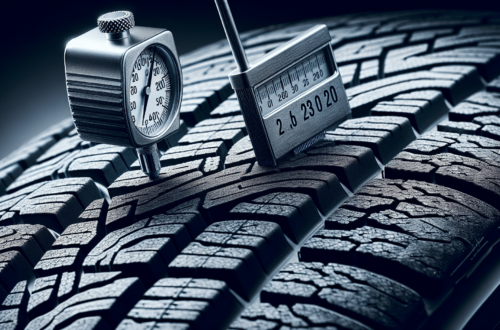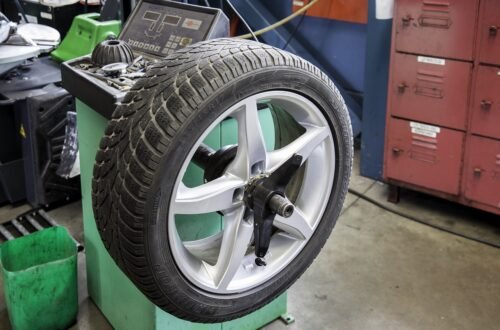You may not realize it, but the condition of your tire tread depth plays a crucial role in your safety on the road. From providing traction on wet or slippery surfaces to improving overall vehicle handling, having the proper tire tread depth is essential for ensuring optimal safety. In this article, we will explore why understanding and maintaining the right tire tread depth is so important, and how it can help protect both you and your loved ones during your journeys on the road. So buckle up and get ready to discover the key to safe and worry-free travels!
Understanding Tire Tread Depth
What is tire tread depth?
Tire tread depth refers to the measurement of the space between the top of the tire’s tread and the bottom of its deepest grooves. In other words, it measures how much of the tire’s surface area is available to make contact with the road. It is typically expressed in millimeters or inches and is an important factor in determining the overall safety and performance of your tires.
Why is tire tread depth important?
Maintaining proper tire tread depth is crucial for several reasons. The tread serves as the tire’s gripping surface and helps to channel away water, snow, and debris. A sufficient amount of tread depth is necessary for optimal traction, which ensures that your vehicle maintains a good grip on the road, especially in challenging weather conditions. Additionally, tire tread depth plays a vital role in efficient braking and handling performance, reducing the risk of accidents and providing a smoother driving experience.
How is tire tread depth measured?
Tire tread depth can be measured using various methods, but the most accurate and reliable way is by using a tread depth gauge. This simple tool allows you to insert a narrow probe into the tire grooves and measure the depth in millimeters or inches. Alternatively, there are also some other methods that can provide a rough estimate of the tire tread depth, such as using a penny or a quarter coin. However, it’s important to note that these alternative methods may not provide the same level of accuracy as a tread depth gauge.
Effects of Worn Tire Tread
Reduced traction and grip
As tire tread wears down over time, the tire’s ability to maintain traction and grip on the road surface diminishes significantly. This can result in decreased stability and control when driving, especially in wet or slippery conditions. With reduced traction, your vehicle may be more prone to sliding, skidding, and losing control, ultimately increasing the risk of accidents and putting you and your passengers in danger.
Increased stopping distance
Worn tire tread also affects the distance it takes for your vehicle to come to a complete stop. When the tread depth is insufficient, there is less contact between the tires and the road, leading to a longer stopping distance. This can be particularly problematic in emergency situations where every inch counts. Having adequate tire tread depth ensures that your vehicle can stop in a timely manner, helping to prevent accidents and potentially saving lives.
Higher risk of hydroplaning
One of the most dangerous consequences of worn tire tread is an increased risk of hydroplaning. Hydroplaning occurs when a layer of water builds up between the tires and the road, causing the tires to lose contact with the pavement. This loss of traction can result in a loss of control, making it difficult to steer or brake effectively. Having proper tire tread depth helps to channel water away from the tire’s surface, reducing the risk of hydroplaning and providing a safer driving experience.

This image is property of pixabay.com.
Legal Requirements and Recommendations
Minimum tire tread depth according to regulations
Different countries and regions have specific regulations regarding the minimum allowable tire tread depth. In the United States, the minimum legal tread depth is generally 2/32 of an inch, which is about 1.6 millimeters. However, it’s important to note that this minimum requirement may vary depending on the particular state or jurisdiction. It is crucial to familiarize yourself with the local regulations to ensure compliance and avoid penalties.
Suggested tread depth for optimal safety
While the minimum legal tread depth is the absolute minimum requirement, it is highly recommended to replace tires once they reach a tread depth of 4/32 of an inch (approximately 3.2 millimeters). This provides a safer margin and allows for better performance in various weather conditions. For winter tires, it is generally recommended to have a minimum of 6/32 of an inch (approximately 4.8 millimeters) for improved traction on snow and ice.
Signs of Worn Tire Tread
Visible wear indicators
Most modern tires are equipped with “wear bars” or “tread wear indicators” that are specifically designed to indicate when the tire tread has reached a dangerously low level. These wear indicators can be found strategically placed in the grooves of the tire, usually in the form of small raised rubber bars that become visible as the tire wears down. When these bars are flush with the rest of the tread, it is a clear indication that the tire needs to be replaced immediately.
Shallow tire grooves
Another obvious sign of worn tire tread is when the grooves in the tire become noticeably shallower. When the depth of the grooves is significantly reduced compared to a new tire, it indicates that the tire has worn down and may not provide adequate traction. Shallow tire grooves can impact your vehicle’s handling and performance, especially in wet or snowy conditions, making it essential to monitor the tread depth regularly.
Uneven tread wear patterns
It is common for tires to wear unevenly due to various factors such as improper alignment, improper tire inflation, or aggressive driving habits. Uneven tread wear patterns can manifest as excessive wear on the edges, center, or one side of the tire. Not only can this affect the tire’s overall performance but it could also be an indication of underlying issues that need to be addressed, such as a misaligned suspension or steering components. If you notice uneven tread wear, it is advisable to have your tires inspected by a professional technician.

This image is property of pixabay.com.
Importance of Regular Tire Inspections
Frequency of tire inspections
Regular tire inspections are vital to ensure the safety and performance of your tires. It is recommended to inspect your tires at least once a month to check for signs of wear and monitor the tread depth. Additionally, it is important to inspect your tires before long trips or during a change in seasons, as these are times when tire performance can have a significant impact on your safety.
How to perform a tire tread check
Performing a tire tread check is a simple process that can be done at home with minimal tools. To check the tread depth, you can use a tread depth gauge by inserting the probe into the tire grooves and taking measurements at multiple points. Start by inserting the gauge into the main grooves, avoiding any elevated wear indicators. Alternatively, you can use the coin method, where you place a penny or a quarter upside down into the grooves. If you can see the top of the President’s head on the penny or if the tread does not reach the top of Washington’s head on the quarter, it’s time to consider replacing your tires.
Benefits of Maintaining Proper Tire Tread Depth
Improved traction and handling
Maintaining proper tire tread depth provides improved traction and handling, allowing your vehicle to maintain a better grip on the road. This is particularly important in adverse weather conditions such as rain, snow, or ice, where the risk of skidding or sliding is higher. With optimal tread depth, your tires can effectively channel away water, slush, and snow, reducing the chances of hydroplaning and providing you with enhanced stability and control.
Enhanced braking performance
Proper tire tread depth is crucial for efficient braking performance. When you apply the brakes, the tread acts as a channel, dispersing water or debris and allowing the tire to maintain solid contact with the road. Worn tire tread can compromise this contact, resulting in longer braking distances and potentially causing accidents. By having adequate tread depth, you can ensure that your vehicle can stop safely and quickly when needed, minimizing the risk of collisions.
Reduced risk of accidents
Maintaining proper tire tread depth significantly reduces the risk of accidents. Having good traction and grip on the road enhances your ability to maneuver your vehicle, especially in emergency situations. With reduced stopping distances and improved handling, you can react more effectively to potential hazards and avoid collisions. By investing in regular tire inspections and replacing worn tires promptly, you are prioritizing your safety and the safety of others on the road.

This image is property of pixabay.com.
Tips for Extending Tire Tread Life
Proper tire inflation
Proper tire inflation is essential for extending the life of your tire tread. Underinflated or overinflated tires can lead to uneven tire wear, causing premature tread wear and reducing the overall lifespan of your tires. Regularly check and maintain the recommended tire pressure specified by the manufacturer to ensure even distribution of weight and optimal contact with the road surface. It is advisable to check tire pressure at least once a month and before long trips.
Rotating tires regularly
Rotating your tires regularly is another effective way to extend the lifespan of your tire tread. Tire rotation involves moving the tires from one location on the vehicle to another, such as swapping the front tires with the back tires. This helps to ensure that the tires wear evenly and at a slower rate, preserving the overall tread depth. Consult your vehicle’s owner manual or seek advice from a professional technician to determine the recommended tire rotation intervals and patterns for your specific vehicle.
Avoiding aggressive driving behaviors
Aggressive driving behaviors, such as sudden acceleration, hard braking, and taking corners at high speeds, can significantly contribute to tire wear. These actions put excessive stress on your tires and cause them to wear faster. By practicing a smoother driving style and avoiding unnecessary harsh maneuvers, you can minimize unnecessary tread wear and extend the life of your tires. Not only will this save you money in the long run, but it will also improve your overall driving experience and safety.
Replacing Worn Tires
When to replace tires
Knowing when to replace worn tires is crucial to ensure optimal safety on the road. As mentioned earlier, the legal minimum tread depth is generally 2/32 of an inch, but it is recommended to replace tires once they reach a tread depth of 4/32 of an inch. Additionally, if you notice any signs of visible wear indicators, shallow tire grooves, or uneven tread wear patterns, it is important to have your tires inspected by a professional and consider replacing them if necessary. It is better to err on the side of caution and replace your tires sooner rather than later to maintain optimal safety.
Choosing the right tires for your vehicle
When it comes to replacing worn tires, it is essential to choose the right tires for your vehicle. Consider factors such as driving conditions, climate, and the specific needs of your vehicle. Different tire types, such as all-season, winter, or performance tires, are designed to perform optimally in specific conditions. Consult with a tire specialist or a reputable dealer to find the right tires that meet your requirements and provide excellent performance, durability, and safety.
How to Measure Tire Tread Depth at Home
Using a tread depth gauge
Measuring tire tread depth at home is a straightforward process with the use of a tread depth gauge. Start by identifying the main grooves on your tires, avoiding any elevated wear indicators. Insert the probe of the gauge into the groove, ensuring that it is perpendicular to the tire’s surface. Take multiple measurements at various points across the tire to calculate the average tread depth. This will provide an accurate assessment of the remaining tire tread and indicate whether or not it is time for replacement.
Alternative methods for measuring tread depth
If you don’t have access to a tread depth gauge, there are a couple of alternative methods to measure the tread depth at home. One popular method is using a penny. Insert the penny into the tire groove with Lincoln’s head facing down. If you can see the top of Lincoln’s head, the tread depth is below the recommended minimum and it’s time to replace the tire. Another alternative is using a quarter. The process is the same, but if the top of Washington’s head is visible, the tire tread is also below the recommended threshold.
Conclusion
Understanding tire tread depth is essential for ensuring optimal safety on the road. By maintaining proper tread depth, you can improve traction, reduce stopping distances, and minimize the risk of accidents. Regular tire inspections and timely replacement of worn tires are key to maintaining optimal safety and prolonging the lifespan of your tires. By following simple tips such as proper tire inflation, regular tire rotations, and avoiding aggressive driving behaviors, you can extend the tread life and maximize the performance of your tires. Remember to measure tire tread depth regularly using a tread depth gauge or alternative methods to ensure that your tires always meet the recommended levels for safe driving. Taking these precautions and investing in your tire’s health will not only help you stay safe on the road but also provide a more comfortable and enjoyable driving experience.





